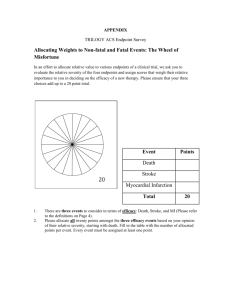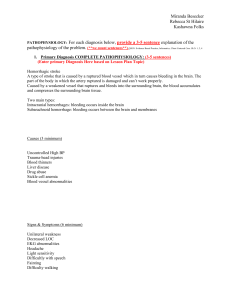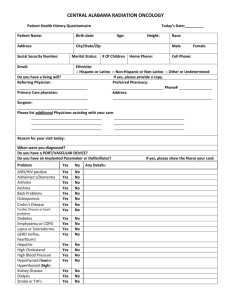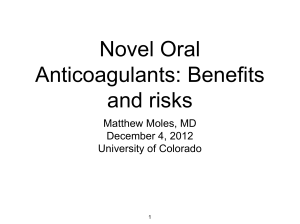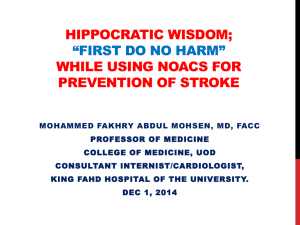Why are the Risks Factors for Recurrent Events the Same as the
advertisement
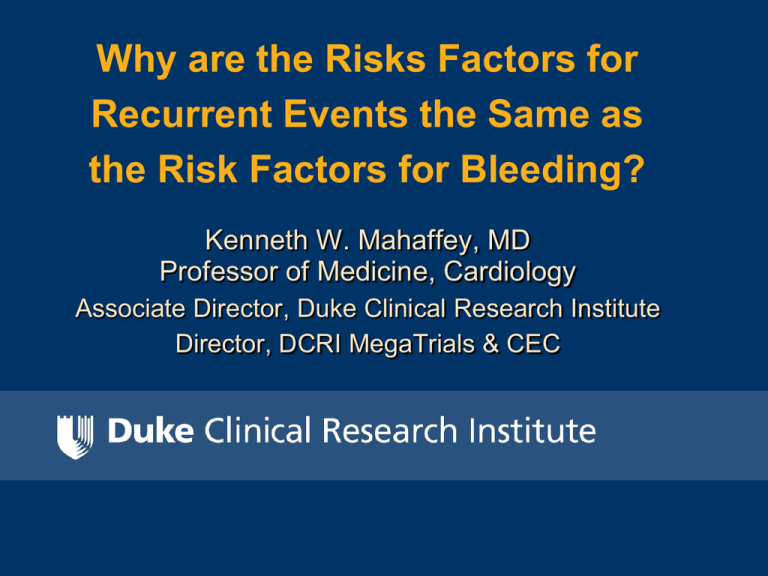
Why are the Risks Factors for Recurrent Events the Same as the Risk Factors for Bleeding? Kenneth W. Mahaffey, MD Professor of Medicine, Cardiology Associate Director, Duke Clinical Research Institute Director, DCRI MegaTrials & CEC Hemostasis and Thrombosis Red Blood Cells Platelet aggregate Fibrin Atherosclerotic Plaque Pathobiology is complex Understanding relationships is important More bleeding with more therapies Balance is critical Efficacy vs Safety Paradigm for Antithrombotic Drug Development “First, do no harm.” Hemorrhagic Risk 2 Hippocrates, c 460-370 BC Increase ASA New drugs Old drugs with new doses Old drugs in new combinations Combination of drugs and devices New drugs and new devices 1 Goal of New Rx 0 0 Decrease 1 Risk of Thrombosis 2- Therapies Always Cause a Combination of: Good Effects Bad Effects Adapted from Furberg, personal slides Risk Scores What are they good for…….. Predicting risk Guiding therapy Populations STEMI NSTE-ACS AF DVT/PE Heart Failure PCI CABG Endpoints Mortality Death/MI Revascularization Bleeding Stroke/SE DVT/PE Sudden Death Variables Clinical Laboratory Electrocardiography Imaging “Omics” Statistical Approaches Univariable Multivarible Courtesy, Lopes RD Stroke Risk in Atrial Fibrillation AFI Age >65, h/o TIA/CVA, DM, HTN If no RF, annual stroke risk <1% C-Indices*: AFI: 0.68 SPAF: 0.74 CHADS2: 0.82 CHADS-VASC: 0.61 SPAF Women >75, h/o TIA/CVA, systolic dysfxn, SBP >160 CHADS2 CHF, HTN, age ≥75, DM, stroke/ embolic event CHADS-VASc CHF, HTN, age ≥75, DM, h/o TIA/CVA/embolic event, age ≥75, vascular dz, female *In origination cohort Risk of Hemorrhage with Anticoagulant Therapy in AF Patients Pisters R. Euro Heart Survey 2010 Correlation between CHADS2 and HAS-BLED scores HAS-BLED CHADS2 0–1 2 ≥3 1 3203 (18%) 2051 (11%) 929 (5%) 2 2807 (15%) 2461 (14%) 1248 (7%) ≥3 1451 (8%) 2056 (11%) 1995 (11%) Data presented at number (%). Modified from Lopes RD, et al. Lancet 2012 Mortality Risk Tertiles Major Bleeding and Mortality Risk in CRUSADE High 1% 8% 23.5% (5,199) (16,044) 9% 15% 8% (6,403) (10,320) (5,762) 23% 10% 2% (706) Mod Low (15,974) Low (6,748) (1,114) Mod High Bleeding Risk Tertiles Alexander KA, et. al. ACC 2008 Bleeding and Mortality Giugliano, JACC 2012 Benefits and Harm: A Complex Interaction Alexander KA, Circulation 2010 Renal Dysfunction a Potent Predictor ROCKET AF: R2CHADS2 Piccini, AHA 2011, Abstract Rapid Evolution New Agents PAR-1 P2Y12 Factor Xa Others ….. The Sweet Spot for Anticoagulation Patient Risks Clinical Context Dose Conclusions Human disease is complex and multifactorial Identification of effective and safe therapies requires testing in the clinical environment Current risk scores for bleeding and ischemic events: Have common predictors Limited by missing of likely key factors genetic, instrumental, environmental Urgent work is needed to better understand the factors associated with ischemic and bleeding events to: Improve clinical decision making Focus further drug development

